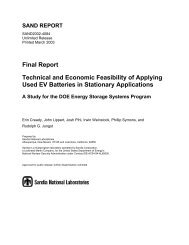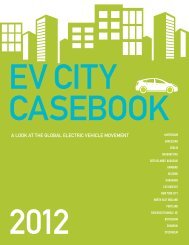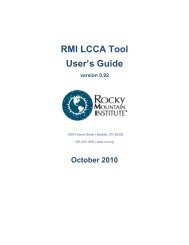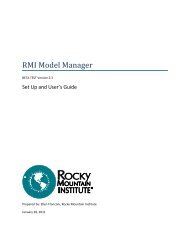Fleet Electrification Roadmap
Fleet Electrification Roadmap
Fleet Electrification Roadmap
- No tags were found...
Create successful ePaper yourself
Turn your PDF publications into a flip-book with our unique Google optimized e-Paper software.
44 primer: electrification of the transportation sectorspecial sectionspecial sectionfleet electrification roadmap 45Expanding the Demand SideIn order to capture the most significant economic, energysecurity and environmental benefits of electric drivetechnology, policymakers and auto industry participantshave tended to focus their attention on light-duty vehicles.Based on the size and importance of the market, thisis clearly justified. The light-duty segment alone makesup approximately 40 percent of total U.S. oil consumptionand more than 60 percent of oil demand in the transportationsector. 99 The high volume of annual light-dutyvehicle sales—which even in severe recessionary conditionsexceeded 10 million units per year—also means thateven a relatively low sales penetration rate can result insignificant uptake of a technology in absolute terms.However, in order to support development of theelectric drive vehicle industry and to help drive downindustry costs for consumers, alternative vehicle marketscould be important in the near-term. The early developmentof the electric drive vehicle and battery industrieswould benefit from a diverse customer base that can helpdrive critical volumes, particularly in the period between2010 and 2015, when charging infrastructure and consumeracceptance issues will slow development of the99 DOE, AEO 2010, Table A-7.personal-use passenger market. Specifically, commercialand government fleet applications stand out as highlyviable market segments based on the operational needs ofthe vehicles and the economic factors that drive vehicleacquisition processes.Based on total cost of ownership modeling conductedfor this report, commercial and governmentfleets could contribute substantial volume commitmentsin the early development phases of the GEV market. Theeconomic attractiveness of electric drive vehicles in certainapplications—coupled with operational enhancementsand targeted use of public policy levers—coulddrive grid-enabled vehicle penetration in U.S. commercialand government fleets to as much as 7 percent of newacquisitions by 2015. In aggregate, the market for EVsand PHEVs in fleet applications could lead to cumulativeunit commitments of more than 200,000 EVs and PHEVsbetween 2011 and 2015.It is important to place these figures in context.Adoption of electric drive vehicles by fleet operatorsshould not be considered as a stand-alone approach toincreasing energy security through reduced petroleumconsumption. Ultimately, the fleet market is not significantenough to drive substantial reductions in nationalA New York Times Dodge Sprinter plug-in hybrid electric vehicle (PHEV), which will be used for newspaper delivery, is seen April 11, 2007 in New YorkCity. The vehicle is the first medium-duty plug-in hybrid vehicle on the East Coast and can operate up to 20 miles in zero-emission electric mode or as ahybrid with a diesel.FIGURE P30U.S. Oil Demand By SectorTransportationLight Truck Auto Heavy Duty Aviation MaritimeMedium DutyMilitaryBusRailOtheroil use. However, based on currently announced NorthAmerican production capacity, fleet operators couldrepresent the equivalent of up to 30 percent of total GEVcomponent capacity in 2015.In the process, fleet operatorswould help expedite thedevelopment of scale efficienciesin the early GEV industry.Moreover, the tendencyof fleet vehicles to be highermileage translates into higherpotential petroleum savingson a per-vehicle basis, maximizingthe efficiency of early,temporary federal incentives.These figures could representsubstantial, realizablevolumes during the early development of the U.S. largeformatlithium-ion battery industry. <strong>Fleet</strong> customerswould provide a stable customer base and much-neededcertainty for manufacturers of batteries, battery componentsand other specialized PHEV and EV parts,including electric motors. Ultimately, the long-termpredictability of large fleet commitments could help todrive cost reductions in PHEVs and EVs that would benefitthe broader consumer market. In the process, fleetelectrification would produce additional benefits.First, fleet customers would contribute to drivingearly volumes in charging infrastructure. Whilecentrally-parked fleets will benefit from single pointinstallation and the ability to charge multiple vehiclesper charger, fleet customers will nearly always prefer toinstall Level II (220v) or Level III (440v) chargers at adepot and perhaps along frequently-traveled routes aswell. Electrified fleets would also help utilities to considerthe impact of PHEVs and EVs on the grid and beginresponding to emerging issues.Finally, fleets would help put EVs and PHEVs onthe road where consumers can see them, increasingNon-TransportationIndustrialCommercialResidentialElectric PowerBased on total cost of ownershipmodeling conducted for his report,commercial and governmentfleets could contribute substantialvolume commitments in the earlydevelopment phases of theGEV market.familiarity with—and perhaps acceptance of—this new,disruptive technology. In some applications, such as utilityand telecommunications service vehicles or urbandelivery trucks, the benefitsof consumer interactionwill be limited tosimply observing PHEVsand EVs in operation. Butin other cases, such asrental cars and taxis, electrifiedfleets will actuallyprovide consumers withan opportunity to interactwith electric drive vehiclesfirst-hand, building confidencethrough experience.All of these benefitswould support the long-term development of the electricdrive industry—the most cost effective and technologicallymature option for addressing America’s dangerousdependence on oil.
















